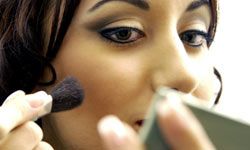Most women (we hope) are very familiar with what is probably the cardinal rule of makeup blending: Never stop applying foundation at your jaw line, lest you end up with the dreaded mask effect. For the most natural results, you should always blend your foundation all the way down your neck.
This beauty commandment, while it's definitely crucial, is just the tip of the blending iceberg. If you've been operating under the assumption that your face is finished as soon as you've applied all of your cosmetics, we're sorry to tell you there's a bit more work to do. With minimal makeup, you might be able to get away without too much attention to blending. But if you're dealing with foundation, eye shadow, eyeliner, blush, lip liner and lipstick, you've gotta blend, blend, blend.
Advertisement
Each cosmetic component doesn't exist in a vacuum -- they all work together to create a flawless face. And you definitely won't have a flawless face if your complicated smoky eyes are three distinct shades and your blush is swiped in a harsh streak down your cheek. So, you need to pay close attention to the details and treat your face like a work of art!
We'll start off with some basic tips on how to blend your makeup seamlessly and then tell you what tools you need to get the job done. Happy blending!
Advertisement

